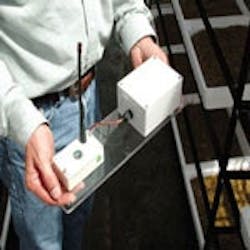Experiments May Reduce Possibility of Future Water Wars
A method that uses roughly only one-hundredth the fresh water customarily needed to grow forage for livestock may leave much more water available for human consumption, as well as for residential and industrial uses. As a byproduct, it also may add formerly untapped solar energy to the electrical grid.
The method for lessening water use is being tested by 42 wireless sensors being installed in a forage-growing hydroponic greenhouse built barely a stone’s throw from the Mexico border under the supervision of the National Nuclear Security Administration’s Sandia National Laboratories, a U.S. national security lab.
Sandia is interested because, says lab researcher Ron Pate, "Disputes over water are possible, if not likely, causes for war in the 21st century."
Echoes Sandia’s director for Geoscience and Environment Peter Davies, "A large proportion of freshwater usage around the world is agricultural. The ability to reduce the amount of water needed for it and thus lessen the possibility of international conflict is extremely important to the security of the U. S. and the world."
The potential savings in water is particularly important in New Mexico and the American Southwest, Mexico, water-parched regions like the Middle East, certain lands between India and Pakistan, and even northern China, where underground water supplies used intensively for agriculture are dipping lower, says Pate. "In all these places, the majority of water use is for irrigated agriculture rather than direct human consumption and other productive uses."
Preliminary indications are that hydroponic greenhouses in New Mexico, for example, could reduce the current 800,000 acre-feet of water to 11,000 acre-feet to produce an equivalent amount (dry weight) of livestock forage, and do this on less than 1,000 acres instead of 260,000 acres — the current amount used for New Mexico production of alfalfa. Eighty percent of New Mexico’s water use is agricultural.
Similar conditions of water use exist in many places in the world.
Source: Sandia Labs
